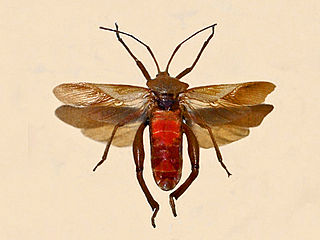Related Research Articles

The Gomphidae are a family of dragonflies commonly referred to as clubtails or club-tailed dragonflies. The family contains about 90 genera and 900 species found across North and South America, Europe, Asia, and Australia. The name refers to the club-like widening of the end of the abdomen. However, this club is usually less pronounced in females and is entirely absent in some species.

The scarce swift is a species of swift in the family Apodidae. It has a disjunct range of presence throughout the Afromontane : Cameroon line, Albertine Rift montane forests, Kenya, Tanzania, Malawi and Mozambique.
Diastatomma bicolor is a species of dragonfly in the family Gomphidae. It is found in Angola, Cameroon, the Democratic Republic of the Congo, Equatorial Guinea, Guinea, Togo, Uganda, and Zambia. Its natural habitats are subtropical or tropical moist lowland forests and rivers.

Gomphidia is a genus of dragonfly in the family Gomphidae. It contains the following species:

Ictinogomphus is a genus of dragonflies in either the family Gomphidae or Lindeniidae. They are medium to large, yellow and black with clear wings. Species occur in Africa, Asia and Australia.

Paragomphus is a genus of dragonfly in the family Gomphidae. They are commonly known as Hooktails.

Phyllomacromia a large genus of dragonflies in the family Macromiidae. They are commonly known as cruisers.

Zygonyx is a genus of dragonflies in the family Libellulidae. They are commonly known as cascaders because of their preference for living beside waterfalls and flying through the spray. They lay their eggs into the wet dangling roots of plants.

Sphedanolestes is a large genus of assassin bugs in the family (Reduviidae), subfamily Harpactorinae. There are more than 190 described species, which are found in southern Europe, Africa and Asia.

Rhynocoris is a genus of assassin bug, family (Reduviidae), in the subfamily Harpactorinae. Species are recorded from Asia, mainland Europe, Africa and North America.
Anthene schoutedeni, the Schouteden's hairtail or Schouteden's indigo ciliate blue, is a butterfly in the family Lycaenidae. It is found in Sierra Leone, the east-central part of the Democratic Republic of the Congo, Ethiopia, Uganda, Rwanda, Burundi, Kenya and north-western Tanzania. The habitat consists of forests.
Henri Schouteden was a Belgian zoologist, ornithologist and entomologist.
Anaphe etiennei is a moth of the family Notodontidae. It was described by Henri Schouteden in 1912. It is found in Cameroon, the Democratic Republic of the Congo and Ivory Coast.

Plectropoda is a genus of squash bugs belonging to the family Coreidae.

Glymmatophora, the Metallic Assassin Bugs, is a genus of assassin bugs belonging to the family Reduviidae.
Ammianus is a genus of lace bugs in the family Tingidae. There are at least 40 described species in Ammianus.
Schouteden's sun snake is a species of snake in the subfamily Natricinae of the family Colubridae. The species, which is monotypic in the genus Helophis, is endemic to Central Africa.
Jean Hector Paul Auguste Ghesquière was a Belgian botanist.

Nagusta is a genus of assassin bugs in the family Reduviidae.
References
- ↑ Martin Schorr; Dennis Paulson. "World Odonata List". University of Puget Sound . Retrieved 12 Oct 2018.
| This article related to Gomphidae is a stub. You can help Wikipedia by expanding it. |